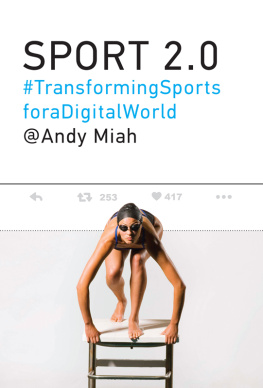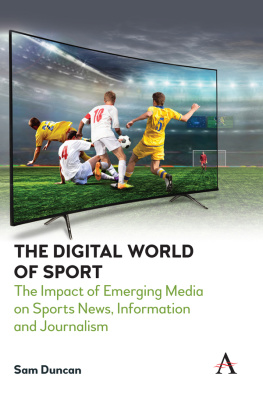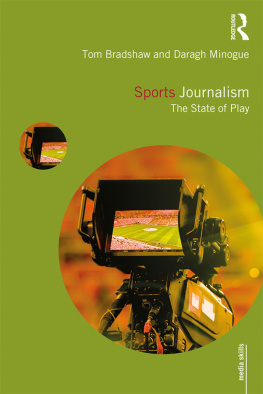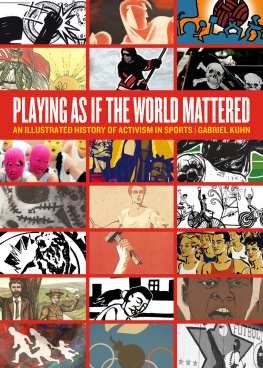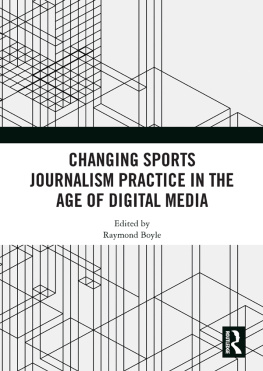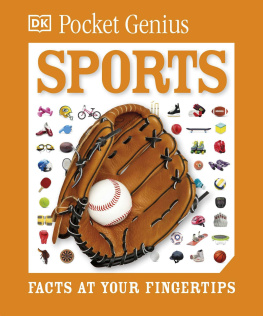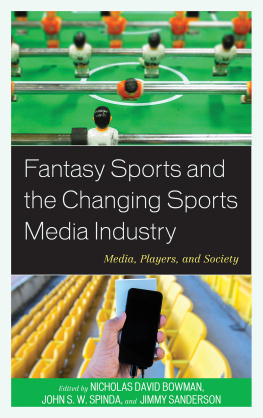
Sport 2.0
Transforming Sports for a Digital World
Andy Miah
The MIT Press
Cambridge, Massachusetts
London, England
2017 Massachusetts Institute of Technology
All rights reserved. No part of this book may be reproduced in any form by any electronic or mechanical means (including photocopying, recording, or information storage and retrieval) without permission in writing from the publisher.
Set in Stone Sans and Stone Serif by Toppan Best-set Premedia Limited. Printed and bound in the United States of America.
Library of Congress Cataloging-in-Publication Data
Names: Miah, Andy, 1975- author.
Title: Sport 2.0 : transforming sports for a digital world / Andy Miah.
Description: Cambridge, MA : The MIT Press, 2017. | Includes bibliographical references and index.
Identifiers: LCCN 2016018952 | ISBN 9780262035477 (hardcover : alk. paper)
eISBN 9780262343107
Subjects: LCSH: SportsTechnological innovations. | Performance technology. | Mass media and sports. | Social media. | Communication in sportsTechnological innovations. | Sports spectatorsEffect of technological innovations on. | OlympicsHistory21st century.
Classification: LCC GV745 .M53 2017 | DDC 796dc23 LC record available at https://lccn.loc.gov/2016018952
ePub Version 1.0
for @ethanmiahgarcia #play
Acknowledgments
A number of people have influenced the journey this book has taken. The first is Dennis Hemphill, with whom I found much common ground in the initial stages of writing. Hemphills work informed my own broader interests in digital technology as not only a mechanism of activism but also a tool for constituting performance spaces and conditions. A second important collaboration during the process of writing was with FACT in Liverpool, particularly through its role in the development of the Abandon Normal Devices festival, which began as a London 2012 Cultural Olympiad project in collaboration with HOME in Manchester and Folly in Cumbria.
My Fellowship at FACT allowed me to engage with a new range of sport stakeholders within the digital art community, many of whom found an entry point into sport through the Olympic Games. Conversations with various people over the period leading up to London 2012 enriched my thoughts about what this book could contribute. I am particularly grateful to Mike Stubbs, Dave Moutrey, Gaby Jenks, John OShea, Leon Seth, Heather Corcoran, and Laura Sillars for the thoughtful conversations we have shared over the years about all things digital. Special thanks also go to Debbi Lander, the London 2012 Creative Programmer in Englands North West, who was a strong advocate for my work on citizen journalism through the #media2012 project, and who was a champion of digital innovation around the London 2012 Games. It was also a pleasure to work with Drew Hemment and the Emoto 2012 team during the Games, which allowed us to create a unique, artistically informed visualization of London 2012 Twitter data.
Other people who have informed this journey are Emma Rich, Kris Krug, Ana Adi, Beatriz Garcia, Daniel Dayan, Monroe Price, Charlie Beckett, Nick Didlick, Larry Katz, Alexander Zolotarev, and Alex Balfour. Their thoughtful contributions during discussions and correspondence have influenced the books range of considerations, and their views became constitutive of the research process that underpinned the work along the way.
I am also especially grateful to the many people within the Olympic movement whom have provided support for my work over the years. In particular, I have felt privileged to work with Anthony Edgar, Head of Media Operations at the International Olympic Committee, whose support and generosity have allowed me to develop the research during the period between London 2012 and Rio 2016. I am also grateful to conversations with Mark Adams, Dick Pound, Alex Huot, and Alex Balfour, and Hisham Shehab for their willingness to share perspectives and insights into Olympic matters and the world of sport.
I am grateful also to Alex Lim and Jay Shin at the International E-Sports Federation, and to Patrick Nally. Many of my ideas about the future of the competitive e-sport industry were crystallized through conversations with them at the seventh eSport World Championships in Seoul during 2015.
Some thanks are due to those who have been directly influential to the funding of this work. First, I would like to thank the University of Salford in Manchester for supporting my broad portfolio of research, and to thank my former employer, the University of the West of Scotland, for its investment in my research over the last decade. Additionally, thanks to the British Academy and the Carnegie Trust for the Universities of Scotland, which funded my empirical work during the Olympic Games from Athens 2004 to Vancouver 2010. Finally, I thank Doug Sery for continuing to believe in this project as it developed from one Olympic Games to the next.
These acknowledgments are offered not just to the time we have shared in the development of my data gathering, but also to the time I have spent wondering what they would think about my overarching ambition for the book and my pursuit of imagining this new vision of sport. I hope the book does justice to the one element that unites all the people I have acknowledged above, which is their willingness and desire to transcend boundaries in their respective endeavors.
Introduction
Intelligent exoskeletal devices (data gloves, data suits, robotic prostheses, intelligent second skins, and the like) will both sense gestures and serve as touch output devices by exerting forces and pressures. Exercise machines increasingly incorporate computer-controlled motion and force feedback and will eventually become reactive robotic sports partners. Todays rudimentary, narrowband video games will evolve into physically engaging telesports .
William Mitchell (1995, p. 19)
William Mitchells vision of future humancomputer interactions helped to shape my interest in the relationship between sports and digital technology. His vision of a world where intelligent exoskeletal devices augment the range of human functions and the sensory experiences we enjoy resonated with my own views about the direction sports would takea view that was also influenced by what was happening in biotechnology. In the late 1990s, cyborg researchers were drawing attention to the common ground shared by digital and biological systems, revealing new possibilities for how their integration could permit our experiencing a new kind of corporeal presence. In this context, it was becoming clear how such approaches to being in the world could create new kinds of possibilities in the realm of performance, not just in sports but in music and dance too.
Small changes in established sports also suggested that the structural parameters of sports were not sufficiently robust to accommodate the changing biological capacities of techno-scientific athletesathletes whose careers, minds, and bodies had been shaped by insights from sport science and technology. For example, the ever-increasing speeds of mens tennis serves generated debate about changing some elements of the sports physical dimensionsfor example, increasing the size of the ball or raising the height of the net. While members of the governing bodies of established sports considered how to modify their games to maintain their integrity, others considered how new kinds of sports, designed for these enhanced humans, may emerge. In the case of the latter, Mitchell imagined a world of remote arm-wrestling, teleping-pong, virtual skiing and rock-climbinga veritable feast of cyborgian experiences made for our growing bionic capacities.
Next page
